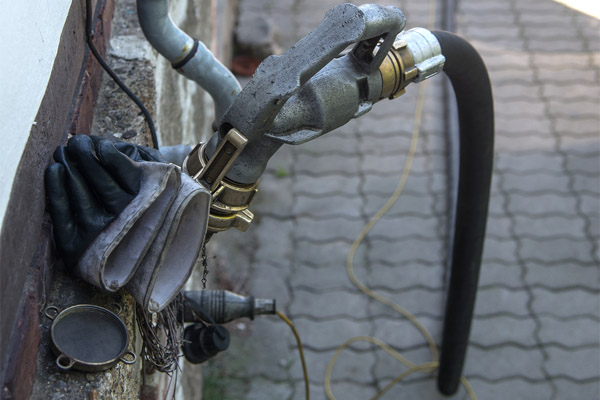
The winter season can be a difficult time for some U.S. states. Homes need to be equipped with reliable heating to ensure safety and comfort during these cold months. Therefore, it is necessary to to tune up your furnace and stock up on heating oil.
Keep in mind that heating oil comes in different types, with its own uses and characteristics. Four of the most common ones are #1 heating oil, #2 heating oil, kerosene, and diesel fuel. It can be argued that #2 heating oil is the most crucial one for your home heating needs.
What Are The Different Types Of Heating Oils?
Table of Contents
Fuel oils are derivatives of crude oil. The crude oil undergoes a distillation process, and each stage results in different byproducts. Furnace combustion allows fuel oils to generate large amounts of heat. The distillates come in varying weights because of the different refinement degrees they went through. Here is a list of these fuel oils from lightest to heaviest:
1. Kerosene

Kerosene is the lightest fuel oil for home heating. It is created through the refinement of #1 fuel oil and the filtration of impurities. As a result, you get a cleaner burn that’s safe to use inside the house. It also has a lower boiling point and viscosity. Kerosene frequently powers portable heaters for outdoor use. It can also be utilized for indoor applications if there are no heating systems installed yet, like in new construction sites. It is a useful fuel oil during camping trips and blackouts. After all, kerosene lamps can light up an area for an extended period. Some models even have odor suppressors and come in pretty designs.
2. #1 Fuel Oil
Kerosene is the resulting byproduct of #1 fuel oil. Therefore, it comes as no surprise that they have many similarities. #1 fuel oil was processed with less time, so it is heavier, has more impurities, and has a higher viscosity. As a result, it does not have a clean burn. It frequently powers outdoor stoves and portable heating units. Bear in mind that #1 fuel oil is not recommended to be used indoors. The exhaust fumes it will produce are toxic to those who inhale it. When outside, these harmful fumes are diluted, so it is not as hazardous.
3. Diesel Fuel

This type of fuel oil is likely what many people are familiar with because it is available throughout the country via fuel pumps. It comes in two kinds, namely, untaxed and taxed. The former is identifiable through its red dye. Untaxed diesel fuel usually powers construction machines and other off-road vehicles. It has low sulfur, so it is recognized as an eco-friendly fuel oil. On the other hand, taxed diesel is undyed and maintains its light green hue. It is mainly used to power trucks and cars on public roads. The only thing that is different between these two types is their price. Taxed diesel fuel is more expensive. When used for home heating, diesel is mixed with #1 fuel oil, which minimizes sludge formation during the winter. Make sure to consult a professional before trying this blend.
4. #2 Fuel Oil

If you consider their chemical composition, diesel fuel is virtually the same as #2 fuel oil. What makes them different from one another is how they are meant to be used. #2 fuel oil is untaxed to ensure that the prices remain low while helping homeowners keep a warm home. This is an essential commodity during winter, after all. It is used to power your furnaces and boilers. Like untaxed diesel fuel, #2 fuel oil also has the same red dye. Many people come to refer to it as home heating oil because of its intended application.
#2 fuel oil can be blended with #1 fuel oil. This will result in high furnace efficiency and fuel oil that has a lower viscosity. This is sometimes called the kerosene mix, while others refer to it as the home heating oil winter blend.
As these two fuel oils are very similar, they can be applied interchangeably in theory. However, bear in mind that the general population does not practice this. If your furnace runs out of fuel and you can’t get an oil delivery any time soon from your oil delivery company, you can buy diesel from the nearest pump. This is impractical to do long-term as diesel is costlier than #2 fuel oil prices. However, it is a good alternative during emergencies.
However, never put #2 fuel oil in a diesel car. This is illegal due to tax regulations. If cops catch you using #2 fuel oil, you might face charges. Make sure to follow the law at all times and utilize each fuel oil for its intended use.
#2 Fuel Oil For Home Heating

The properties that #2 fuel oil possess make it the most widely used out of the four fuel oil options mentioned above. It generates the largest amount of heat as per its high British Thermal Unit (BTU) rating.
Homeowners call their local oil supplier for delivery. The company will then send a truck full of #2 fuel oil. The delivery personnel might also let their clients know of any other blends that might fit their oil tank or the area’s prevailing temperatures. You could have a tank that is installed above ground outside. This means it is more vulnerable to the cold. Therefore, you can opt to use a blend of #1 and #2 fuel oils so that it is less likely to form sludge. You can also choose a mixture of #2 fuel oil and kerosene to get a cleaner burn.
Call Skylands Energy Service For Reliable Oil Deliveries
 Skylands Energy Service offers reliable and affordable heating oil delivery services throughout Central New Jersey. We have many delivery plans and financing options available to meet your needs.
Skylands Energy Service offers reliable and affordable heating oil delivery services throughout Central New Jersey. We have many delivery plans and financing options available to meet your needs.
Likewise, our family-owned company has many different types of home comfort services. This includes heating oil delivery, coal delivery, plumbing services, heater repair, heating system maintenance, heater installations, and more. Be sure to give Skylands Energy Service a call today to see what we can do for you. All of our services come with a guarantee to ensure your satisfaction. Call now!
Contact us now at (908) 707-1776 to find out more!

